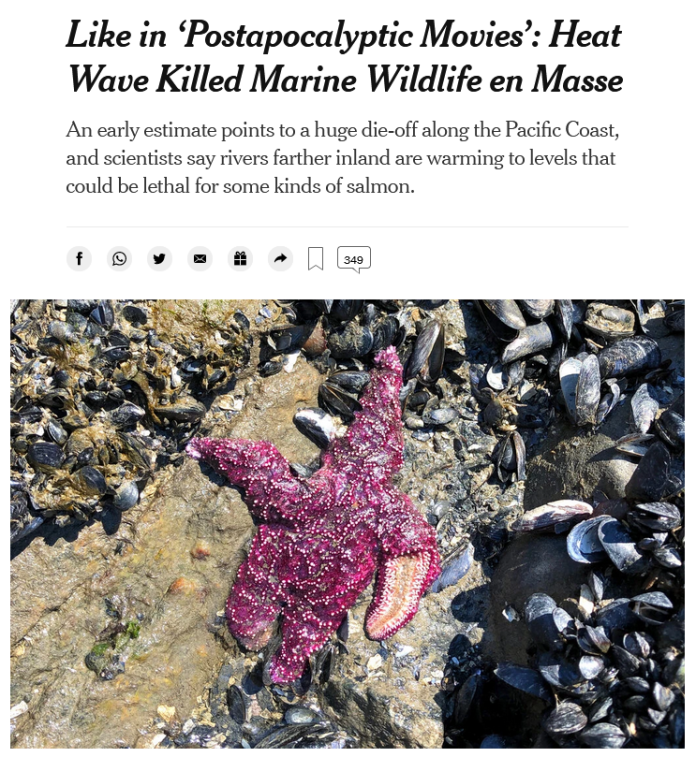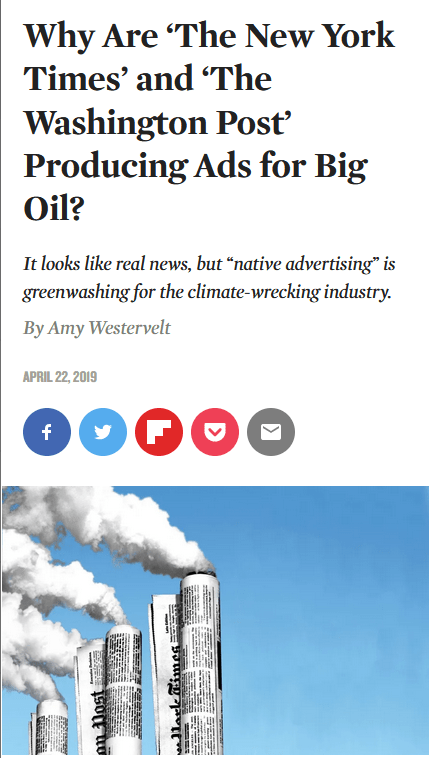When detailing catastrophic weather events, prominent corporate news outlets show less reluctance than in the past (FAIR.org, 9/22/20, 4/22/21) to prominently pointing out that these events are caused by human-driven climate change. But when humans seek to take aggressive action against this aggressive reality, reporters frame those goals as lofty and unlikely to succeed.
Admitting the human cause

A recent New York Times article (7/9/21) describes a sickening scene in the wake of the Pacific Northwest’s heat wave:
Dead mussels and clams coated rocks in the Pacific Northwest, their shells gaping open as if they’d been boiled. Sea stars were baked to death. Sockeye salmon swam sluggishly in an overheated Washington river, prompting wildlife officials to truck them to cooler areas.
Scenes like this, the article points out, will become more frequent and intense as climate change progresses and creates domino effects up the food chain:
Such extreme weather conditions will become more frequent and intense, scientists say, as climate change, driven by humans burning fossil fuels, wreaks havoc on animals and humans alike.
Hellish landscapes
The Times also dedicated an entire section online to the North American heatwave, with stories depicting hellish landscapes of forest fires, droughts and heat-related deaths. It stressed that scientists have attributed these disasters to climate change:
Heat, drought and fire are connected, and because human-caused emissions of heat-trapping gases have raised baseline temperatures nearly two degrees Fahrenheit on average since 1900, heat waves, including those in the West, are becoming hotter and more frequent.
Across the Atlantic in Western Europe, otherworldly images showed freakish floods destroying towns and causing death tolls well into the hundreds. “Flood Deaths Are Rising in Germany and Officials Blame Climate Change,” NPR.org (7/16/21) reported. The New York Times’ headline (7/16/21) read, “Europe Flooding Deaths Pass 125, and Scientists See Fingerprints of Climate Change.” “European Officials Say ‘Climate Change Has Arrived’ as Deadly Floods Engulf Entire Towns,” CNN.com (7/16/21) announced.
Who exactly are we talking about?

But as FAIR (7/2/21) has pointed out, exactly which humans are most responsible for climate change—like fossil fuel executives—matters. All of the above pieces—except the Times’ July 9 article on marine life—fail to specifically mention human’s burning of fossil fuels as the root cause of global warming.
Many corporate outlets have an interest in not rocking the fossil fuel boat too much. Billionaire Robert Denham serves on boards of both Chevron and the New York Times board, and attorney Ted Boutrous Jr. is a lawyer for both companies (FAIR.org, 7/2/21). The Times, Washington Post and Politico have also run hundreds of thousands of dollars worth of greenwashing propaganda from Exxon, Shell and Chevron—ads designed to look like news articles (The Nation, 4/22/19).
Though reports increasingly acknowledge climate change’s effect on extreme weather, that still doesn’t always happen. In a New York Times story (6/29/21) on the Pacific Northwest’s “Heat Dome,” the paper described an apocalyptic scene, but insisted that “tying a single heat wave to climate change requires extensive attribution analysis”—as if some weather happens independently of the climate (FAIR.org, 7/2/12).
Softening the blow of devastating weather events means not only deflecting blame, but also using euphemisms. Bloomberg’s coverage (7/16/21) of Europe’s floods also correctly attributes them to climate change, but the story is listed under its section “Climate Adaptation,” as if to suggest humans should “adapt” to these catastrophes (perhaps by growing gills?), and accept them as the status quo, instead of trying to take action to prevent them.
‘Ambitious blueprint’
And when it comes to talking about what can actually be done about climate disruption, corporate media are remarkably cagey—seemingly more comfortable mourning the planet and maintaining the fatalistic status quo than with promoting solutions (FAIR.org, 3/1/20, 1/31/20).
Take the European Union revealing its “Fit for 55” plan (also known as the European Green New Deal) to cut its carbon emissions by 55% of their 1990 levels by 2030, which came just days before three of its countries were submerged meters-deep in floodwater.
In the New York Times (7/14/21), “Fit for 55” was an “ambitious blueprint,” even as swelling rivers took hundreds of lives in Western Europe (7/16/21). The article focused mainly on the political and trade implications of Europe’s Green New Deal, and does not look at its actual environmental impacts. The piece mentions only in passing that “some environmentalists criticized” the plan, linking a tweet from youth activist Greta Thunberg:
CNN (7/14/21) and NPR (7/14/21) also used “ambitious” to describe the plan, contradicting themselves when they also briefly mentioned that some scientists are criticizing it for not being ambitious enough.
Is a plan really “ambitious” if achieving it is an existential necessity, and still may not be enough to combat climate change’s already-devastating effects? Sure, Europe’s climate plan is “ambitious” by the rest of the world’s standards, but that’s a high jump over a low hurdle. The EU is the third-largest greenhouse-emitter in the world, behind China and the United States. Calling the EU’s plan “ambitious” serves to maintain the status quo of “climate adaptation” amid destruction, instead of taking action to prevent that destruction from becoming any worse.
Necessary doesn’t mean easy
“Becoming any worse” is the operative phrase here. The International Panel on Climate Change (IPCC)’s models indicate that even if we achieve the goal of reaching zero carbon emissions by 2050, we’d still need to draw carbon out of the atmosphere in order to prevent warming past the Paris Agreement’s 1.5° Celsius cap (EcoWatch, 11/13/20). The journal Nature (7/14/21; NPR, 7/15/21) recently published a study that revealed parts of the Amazon Rainforest now emit more carbon than they absorb.
Saying that the EU’s plan is necessary doesn’t mean it won’t be difficult to achieve. Its proposals to tax certain imports from countries with weaker environmental rules, raise the price of fossil fuels and eliminate the sale of gas- and diesel-powered cars by 2035 will surely cause trade disputes.
But saying it is “ambitious” implies it is an impressive, but unnecessary, over-achievement.
Launching a commercial space-flight industry? That’s “ambitious.” Steeply reducing carbon emissions to avoid further human-caused catastrophe, while streets flood, fires burn, people die of heat stroke and rotting animals wash up on shores isn’t a nice-to-have. It’s the only way forward, unless, of course, we settle for Bloomberg’s “climate adaptation.”
Related posts:
Views: 0
 RSS Feed
RSS Feed

















 July 25th, 2021
July 25th, 2021  Awake Goy
Awake Goy 

 Posted in
Posted in  Tags:
Tags: 
















